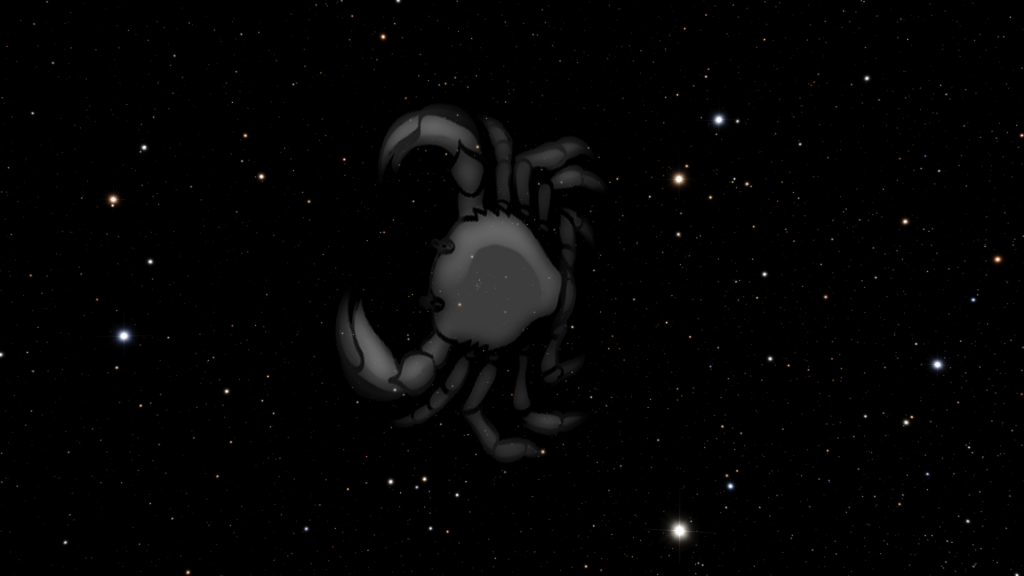The Taurus constellation can be observed in the northern hemisphere. In the middle latitudes, it is visible almost all year round with the exception of April, May and June. The best period for observations is from December to February. The easiest way to find this constellation is if you find three bright stars of the Orion belt in the sky in winter. To the right and slightly higher, you can see the bright star Aldebaran (alpha Taurus), and not far from it are the Hyades and Pleiades – the brightest scattered clusters of stars. The Taurus constellation is a zodiac and one of the most beautiful in the starry sky, containing many bright and interesting objects visible to the naked eye.
How can you see Taurus constellation in the sky? In large cities, because of the glare and dust, it is not so well visible, so animations and an image are prepared for you outside the city, in the mountains and if you look at it in space, from orbit.
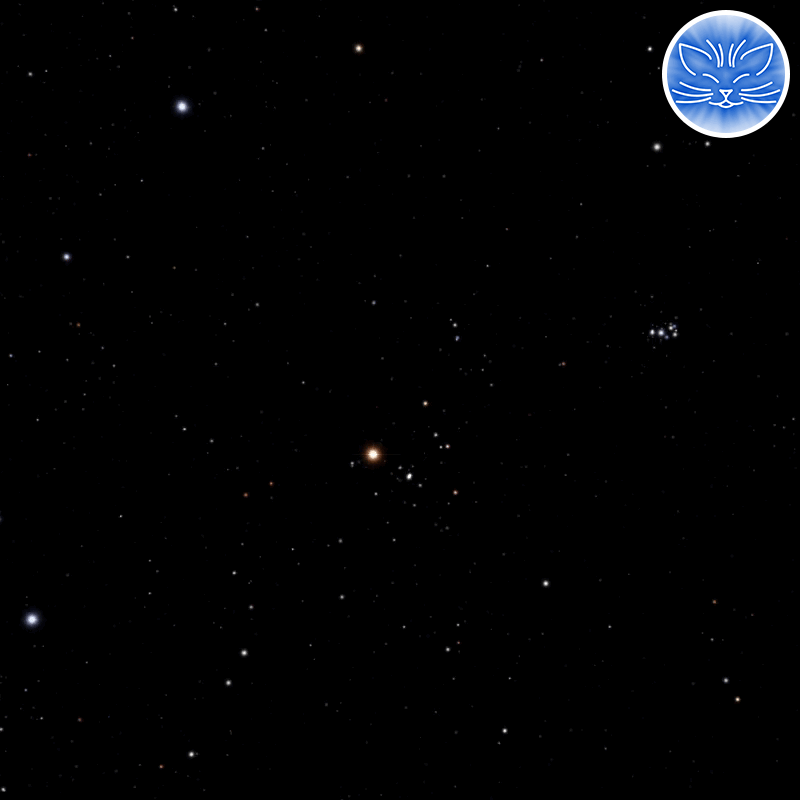
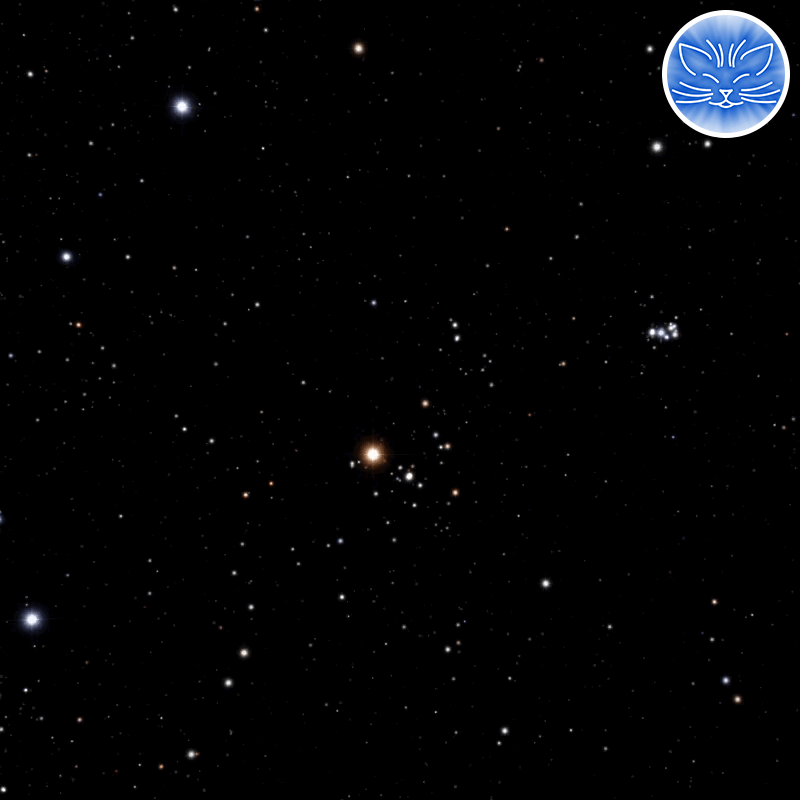
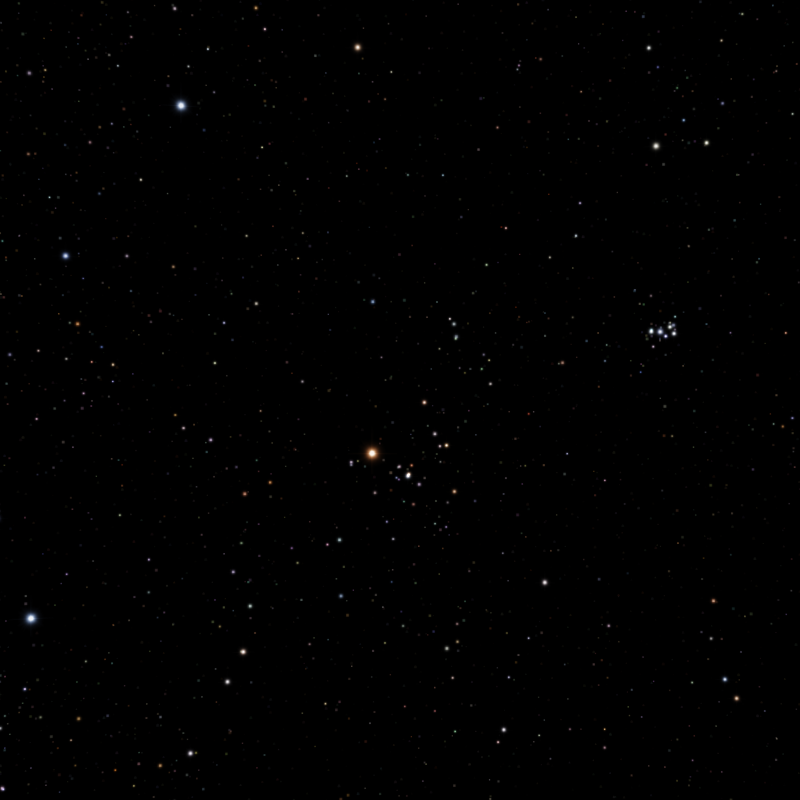
The brightest stars of this constellation are Aldebaran, Elnath, Alcyone and Tianguan. Aldebaran (α Tau) is the eye of Taurus, the brightest star in the constellation and one of the brightest in the starry sky. Its main component Aldebaran A has an apparent magnitude of 0.87, which puts it in 14th place among all stars in brightness. The size of Aldebaran A is 44 solar radii, the distance from us is about 65 light years. The color of the star is red and it belongs to normal giants. The second component of Aldebaran B is a red dwarf.
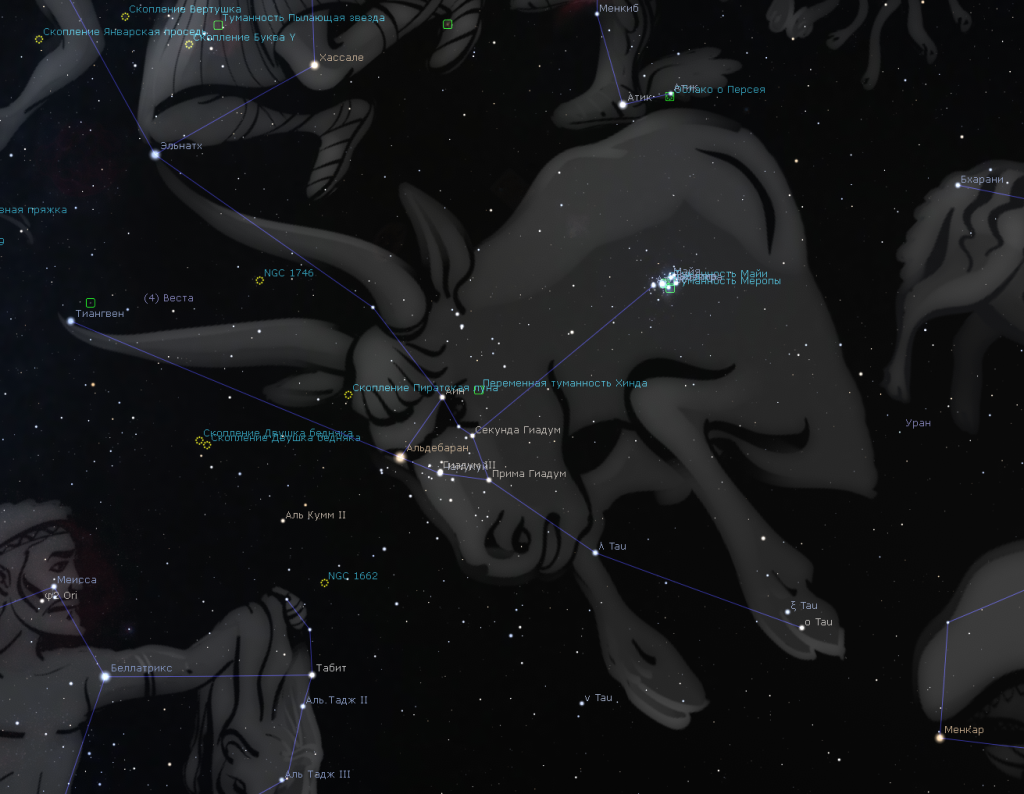
Elnath (β Tau) is one of the horns of Taurus, the second brightest star in the constellation. The apparent magnitude is 1.65. The radius of the star exceeds the solar one by 5-6 times, and the distance from us is about 130 light years. This star is also notable for the fact that Ptolemy, in his Almagest collection of constellations, had it in common with Auriga constellation and was described as follows: “The star at the end of the northern horn, identical with the star on the right leg of Auriga.” In fact, it belonged to two constellations. The Arabs characterized this star as “the ankle of Holding the reins.”
Alcyone (η Tau) is the neck of Taurus, the brightest star in the scattered Pleiades cluster. It takes its name from the name of one of the Pleiades – Poseidon’s beloved Alcyone. Its apparent magnitude is 2.85. The star is a multiple with four components. Tianguan (ζ Tau) is the second of the horns of Taurus, the fourth brightest star in the constellation. Its apparent magnitude is 2.97 and its distance is 417 light-years. Ptolemy describes this star as “the star at the end of the Southern Horn.” The star is a multiple with two components. Both Tianguan and Alcyone belong to Be stars, they have a very fast rotation, which leads to the outflow of matter from the equator and the formation of a circumstellar disk.
Other interesting objects of Taurus constellation
In addition to the many stars, other interesting objects can be observed in this constellation – the Pleiades and Hyades, as well as the Crab Nebula.
The Pleiades are the scattered star cluster M 45 and an asterism in the Taurus constellation. It is one of the closest to us, its distance is about 410 light-years, and one of the most spectacular even to the naked eye. The Pleiades occupy a space in the sky several times larger than the area of the full moon. Another name for this cluster has Slavic roots – Stozhary, Seven Sisters. In Japan, the Pleiades are known as Subaru. The Subaru car brand of the same name has six of the most striking “sisters” of the cluster on its emblem.
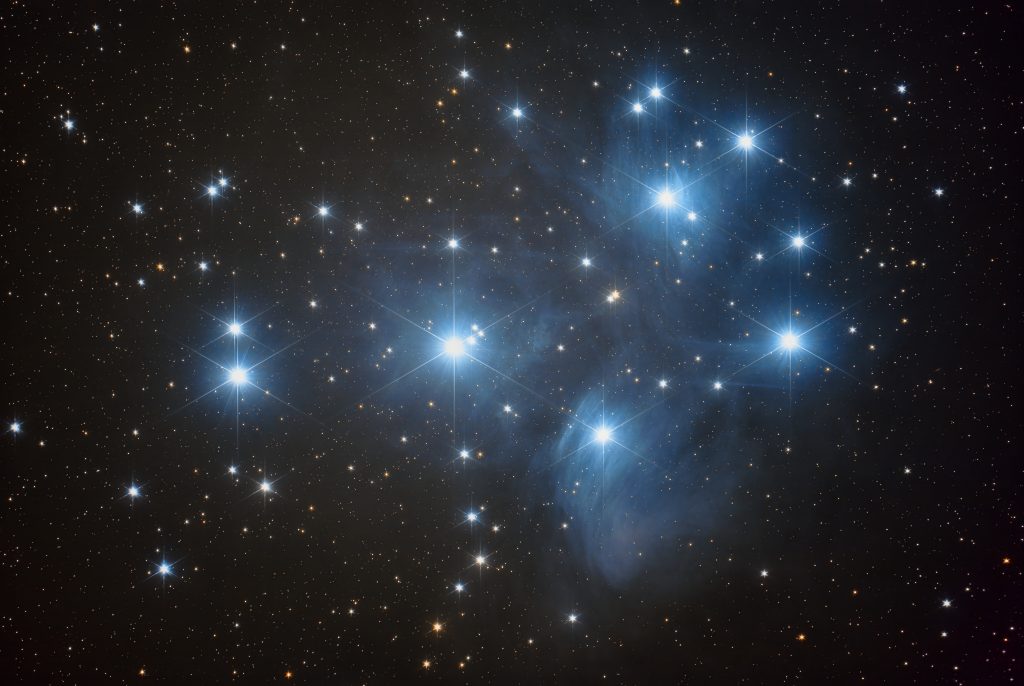
The mythical king Atlas and his beloved Pleione had seven daughters – Alcyone, Asterope, Maia, Merope, Taygeta, Celaeno and Electra. All of them fell into the starry sky, and initially the brightness of the “sisters” was the same. But after Merope married the mortal Sisyphus, “her star” dimmed.
In fact, of course, this cluster does not consist of 7 or 9 stars, but of about three thousand stars. However, most of them are too small. Of all the stars, only 16 have a magnitude less than 6.5. A person with normal eyesight sees 6 or 7 stars with the naked eye, sharp-sighted people see about 10. Galileo, in his imperfect telescope by our standards, saw 36 stars in the Pleiades. The main stars of the cluster are, of course, the seven sisters and their parents. The brightest of the Pleiades is Alcyone (η Taurus). Its stellar magnitude is 2.87. It is a multiple star consisting of four components. It is 10 times larger than our Sun in size, and two thousand times more luminous. The least bright star of the main stars of the Pleiades is Celaeno. Its stellar magnitude is 5.46. It is 3 times larger than the Sun in size, and 240 times more luminous.
The Pleiades are a compact cluster and quite young. Some of the stars that make up the cluster did not appear earlier than 2.5 million years ago. If this is indeed the case, then their age is of the same order as the age of mankind. In 1859, a light transparent nebula was discovered, a kind of veil in which the Pleiades are immersed. It is non-self-luminous and reflects the light of the stars in it. It consists mainly of the smallest solid cosmic dust.
Hyades is another large scattered cluster in the constellation Taurus, which is the closest to us. It is about 150 light years away. The cluster consists of about 700 stars, but Aldebaran, although located in the same part of the sky, does not belong to it, but is only projected onto it. About 800 thousand years ago, the Hyades flew past the Sun at the shortest distance from it and were 60 light-years away from us. According to some scientists, in 65 million years they will be so far away from us that they will occupy an area much smaller than the full Moon in the sky, and their brightest stars, now clearly visible to the naked eye, will become faint stars of the 12th magnitude. Other scientists believe that after 30 million years, the Hyades, continuing to lose their mass, will completely disintegrate.
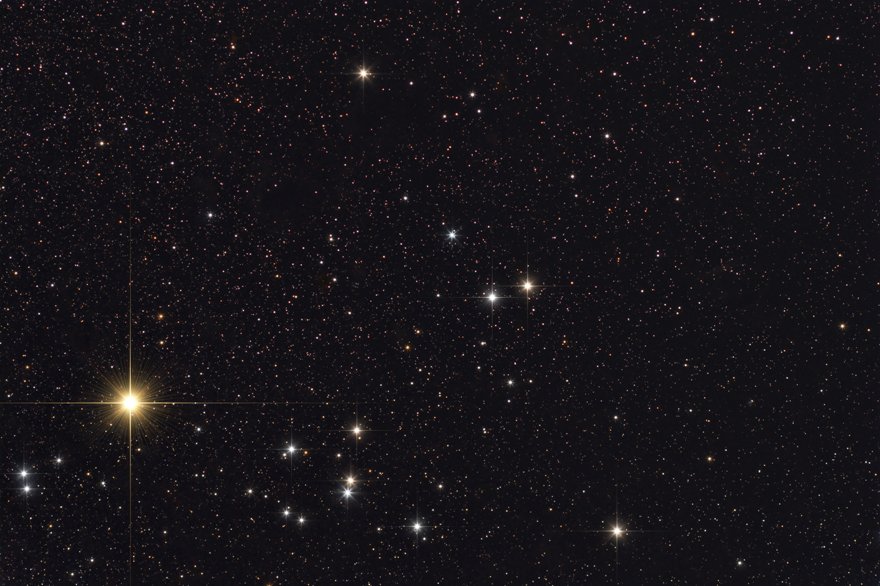
The Hyades are 650 million years old, which may indicate a common origin with the Beehive Cluster located in the Cancer constellation. In Greek mythology, the Hyades were nymphs, half-sisters of the Pleiades. They helped Zeus hide his illegitimate son Dionysus from Hera and her titans. Previously, before that, the father turned the boy into a baby goat or a lamb. In thanks, the Hyades were lifted up into the starry sky. The Hyades, like the Pleiades, are probably mentioned in the Bible.
Another very interesting object in the constellation is the Crab Nebula M 1 (NGC 1952). This gaseous nebula is a remnant of the supernova SN 1054 and a plerion, meaning it is fueled by the pulsar’s wind. The nebula is located at a distance of 6,500 light-years from us and has an apparent magnitude of 8.4. It is expanding at a speed of 1,500 km per second. Thus, even in photos taken with an interval of 20-30 years, you can see the expansion of the Crab Nebula. According to the records of Chinese astronomers, a supernova explosion was observed on July 4, 1054. The red-and-white flash was visible for 23 days, even in the daytime.
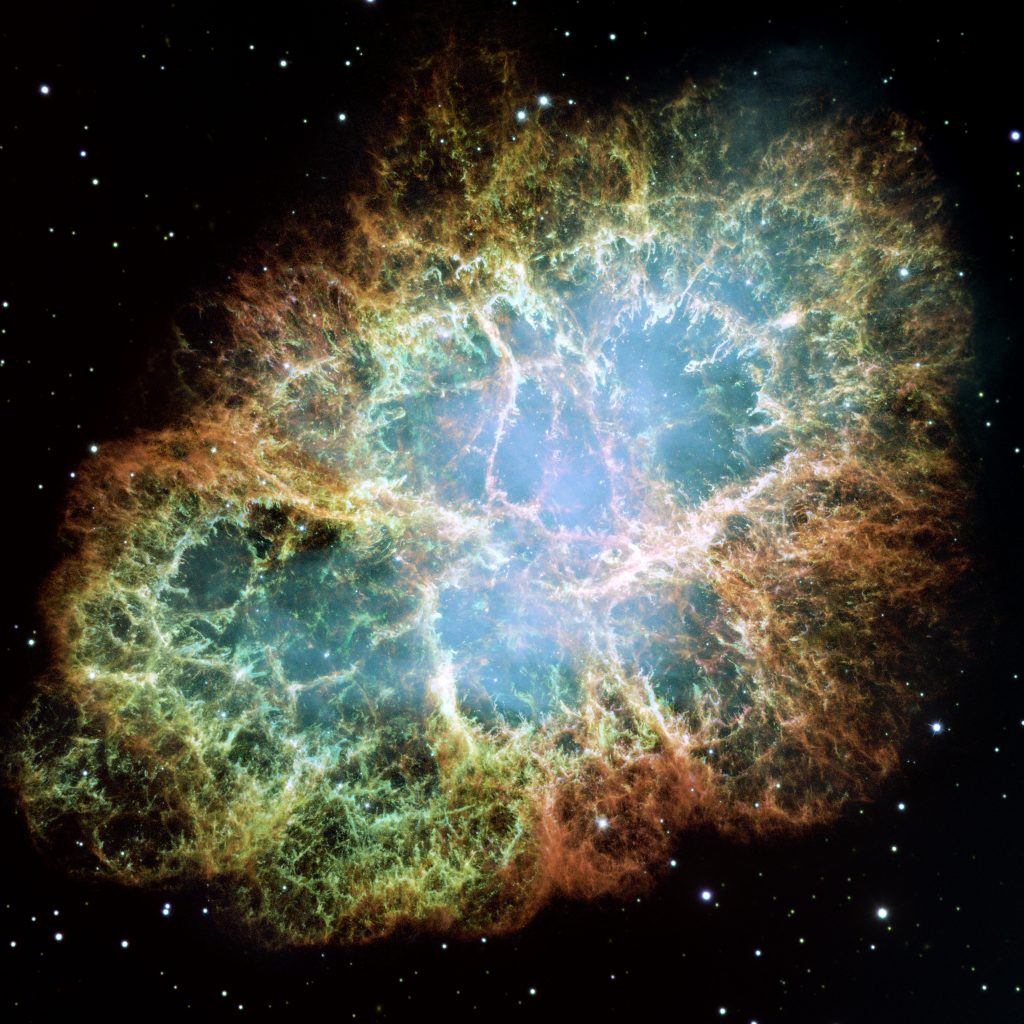
The nebula was first observed by John Bevis in 1731. In 1758, the scientist Messier was looking for one of the comets in this area of the sky and almost confused a previously unknown nebula with it. It was this event that prompted him to compile his well-known catalog of nebulae, in which the Crab Nebula is number one. The M 1 is one of the most powerful sources of radio emission. In the center of the nebula is the Crab Pulsar, a neutron star, what remains of a supernova explosion. The pulsar is only 25 km in diameter, and the temperature is at least 150,000 degrees, which is impossible for ordinary stars. Despite such a small size, the mass of the pulsar is comparable to the mass of the Sun, which indicates the enormous density of matter of a neutron star. In the X-ray and gamma-ray ranges, this pulsar is the strongest constant source of such radiation in our Galaxy.
Mythology of Taurus Constellation
The constellation Taurus has a three-letter abbreviation of Tau. It is recognizable, not very large – the 17th largest of all 88 constellations, and one of the oldest. At the time of Ptolemy, it was included in the catalog of the starry sky (there were 48 constellations in total). The Latin name Taurus means a prehistoric bull. The Taurus constellation has many legends among different peoples, each of which is interesting in its own way. Let’s look at some of the most famous ones.
According to one of them, Zeus took the form of a beautiful white bull to abduct Europa, the legendary Phoenician princess. Taurus swims across the Hellespont, so its back part, submerged in water, is much less bright, unlike the large head.
According to another legend, Taurus is the mistress of Zeus Io, whom he turned into a heifer to protect from his jealous wife Hera. However, this trick did not work and Hera convinced her husband to give Io to her. Then the goddess assigned Argus Panoptes, a giant with a hundred eyes, to watch the heifer. But Zeus, with the help of Hermes, managed to lull Argus to sleep and kill him, free Io, even though she remained in the form of a cow. To take revenge, Hera sent a gadfly to constantly sting her rival and make her wander the world. Eventually, she escaped across the Ionian Sea to Egypt, where Zeus restored her to human form. There she bore him a son and a daughter.
There is also a third legend, according to which Taurus is the Cretan bull described in the Twelve Exploits of Hercules. The seventh task of Hercules was to capture the Cretan bull, which wreaked havoc on the island, trampled crops, destroyed orchards and everything that came in his way. After completing the task, Hercules saddled a bull and sailed across the sea from Crete to the Peloponnese.
Have you seen this constellation? Have its objects been observed through binoculars or a telescope? What is your favorite constellation? Which of the legends do you consider the most appropriate? Share your impressions in the comments.




